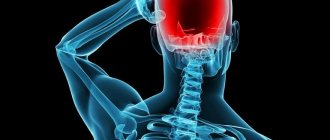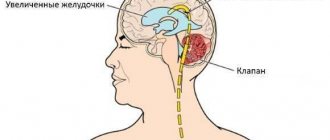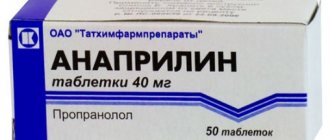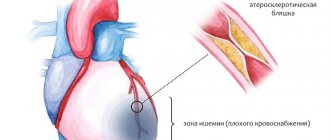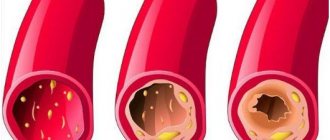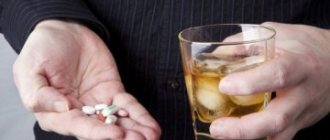What causes an increase in ICP?
The main culprits of increased ICP are:
- infectious processes of the peri-cerebral membranes (meningitis, arachnoiditis, others);
- cerebral edema;
- stroke;
- lack of oxygen;
- encephalitis;
- violation of venous circulation;
- hematomas;
- vascular disorders;
- failures of cerebrospinal fluid absorption processes;
- hydrocephalus;
- traumatic brain problems caused by trauma;
- neoplasms of various origins;
- hyperthyroidism;
- long-term use of certain medications.
If ICP is not controlled, severe complications are possible (cerebral edema, blindness, epilepsy).
Symptoms of ICP
With high ICP, patients present the following complaints:
- nausea, possible vomiting;
- shortness of breath (variable degrees of severity);
- sweating;
- pain in the muscles;
- swelling of the face;
- state close to fainting;
- chills;
- vegetative-vascular dystonia;
- irritability, anxiety, apathy;
- severe headaches, worsened by the slightest movements;
- constant feeling of heaviness in the head;
- dark circles under the eyes;
- visual impairment: double vision; pupils react worse to lighting);
- other.
Tablets for headaches and high blood pressure
Headache often occurs with high blood pressure - from 140/90 mmHg. The pain syndrome can be continuous, manifested by a feeling of “squeezing”, pulsation. The source of pain is concentrated in the back of the head. A medicine for headaches with high blood pressure will help alleviate the condition and lower the levels. You can try taking pills for intracranial pressure, but it is better if your doctor prescribes the medications for you.
Among the reviews, many drugs are mentioned - common remedies for headaches that can normalize well-being with high blood pressure. Help relieve severe pain:
- Pentalgin;
- Isoptin;
- Coriol;
- Acebutolol;
- Askofen;
- Farmadol;
- Citramon;
- Nurofen forte;
- Analgin;
- Panadol Soluble.
Is it possible to reduce intracranial pressure?
Of course, there are medications that normalize ICP. Tablets and other remedies help, but the main task is to identify the cause and eliminate it. The main purpose of medications is to improve blood circulation and liquor formation.
In some cases, with benign hypertension, normalization of the condition is carried out without drugs to reduce intracranial pressure.
The following techniques will help regulate ICP without medications:
- exercise therapy;
- pool;
- Fresh air;
- normalization of work and rest;
- eliminating bad habits;
- breathing meditations;
- massage of the cervical-collar area;
- balanced diet (less fat, more fiber and vitamins). Remove coffee, pickles and spicy foods from your diet;
- eliminate stress.
When is medication necessary?
With a significant increase in ICP and aggressiveness of the problem, medications are needed. The severity of symptoms also influences the choice of medications and duration of therapy for ICP.
For weather-dependent people, even with a slight increase in ICP, it is recommended that hypertension be corrected with tablets or other forms of medications.
In pediatrics, any changes in ICP are subject to correction. The child should be observed by a neurologist. Self-treatment is unacceptable, even with symptomatic medications. In acute cases, when a child develops a “bouquet” of ICP symptoms, an ambulance should be called immediately.
Video on the topic
Psychotherapist of the highest category about the drug Piracetam:
If the rules of administration and dosage are followed, therapy with Piracetam can give a good effect. Compliance with the rules for using the medicine will also allow you to avoid overdose and side effects that arise due to exceeding the permissible minimum of the medicinal substance entering the body.
The information on the MyMedNews.ru website is for reference and general information, collected from publicly available sources and cannot serve as a basis for making a decision on the use of medications in the course of treatment.
MyMedNews.ru
And we also have
Features of the effect of Analgin on the body: does the drug increase or decrease blood pressure?
Basic means for reducing ICP
Hormonal agents (corticosteroids)
These drugs include: prednisolone and dexamethasone. These drugs have a strong therapeutic effect. Prednisolone has a pronounced immunosuppressive, anti-inflammatory, antishock, antiallergic and antitoxic effect. Dexamethasone is also an effective hormonal agent, but has a different composition. The potency is slightly weaker than prednisolone.
Beta blockers
With high ICP, the blood vessels of the brain suffer, and their prolonged narrowing disrupts blood flow.
At the same time, vascular permeability increases. The danger is as follows: plasma should not be allowed to escape into the intercellular space, because this promotes compression of neurons. Beta blockers effectively block nerve impulses, reduce heart rate, and have a hypotensive and anti-ischemic effect. Drugs in this group: bisoprolol, egilok, anaprilin, others.
Important! These drugs should not be abruptly discontinued. Self-medication can lead to serious consequences.
Diuretics (diuretics)
These drugs include diacarb, hypothiazide, Lasix, liprozide and others.
The purpose of diuretics is to remove excess fluid from the body. Thanks to this action, ICP is reduced and swelling is eliminated. Diuretics are prescribed for long-term therapy and in emergency cases, used in tablets and administered intravenously.
Important! Diuretics remove potassium, sodium, and chlorine. It is necessary to carry out laboratory monitoring of these indicators and, if necessary, replenish lost electrolytes. For example, when potassium decreases, panangin is prescribed.
Vasodilators (vasodilators)
Magnesia (magnesium sulfate) is considered one of the popular and cheapest remedies. The drug perfectly reduces blood pressure. Emergency physicians often use this drug intramuscularly or intravenously. Under the influence of magnesium, the pressure of the cerebrospinal fluid decreases. The drug acts quickly, but high doses can cause a collapsing state. Vasodilators also include cinnarizine, euffilin, vinpocytine, and others.
- The best drugs to boost immunity;
- How to quickly cure acute respiratory infections in adults - more details;
- How to quickly bring down the temperature.
Use of the drug Cavinton Forte in patients with dyscirculatory encephalopathy
About the article
9252
0
Regular issues of "RMZh" No. 10 dated May 29, 2004 p. 626
Category: Neurology
Author: Karpov A.V.
For quotation:
Karpov A.V. Use of the drug Cavinton Forte in patients with dyscirculatory encephalopathy. RMJ. 2004;10:626.
The drug Cavinton has been used for more than 30 years both in our country and in 40 other countries around the world. The main pharmacological mechanisms of its action have been studied in detail, and the features of the drug’s effects at the molecular, cellular and organ levels are described. Tremendous experience has been accumulated in its practical use in patients with various forms of pathology of the central nervous system. Cavinton firmly holds a leading position among drugs that have a proven significant positive effect in patients with various forms of cerebrovascular pathology. At the same time, new information obtained in recent years, in particular, about the presence of neuroprotective properties in Cavinton, allows us to re-evaluate the mechanisms of implementation of its clinical effects, and to a certain extent revise the existing views on the clinical use of the drug. In this regard, the release of a new dosage form – Cavinton Forte – is of great satisfaction.
One of the cardinal directions of the pharmacological action of Cavinton is the normalization of vascular tone and improvement of cerebral blood flow. This is due to the fact that the drug prevents the absorption of the vasodilator adenosine by red blood cells and thus increases its content in the blood. By inhibiting phosphodiesterase, Cavinton increases the concentration of cAMP in smooth muscles, and in terms of the severity of this effect it significantly exceeds all other vasodilators. Cavinton has a positive effect on macrocirculation , which is most pronounced in small and medium-sized arteries. It is noteworthy that its vasoactive effect is eutonic in nature. Cavinton has a normalizing effect on cerebral vessels with both increased and decreased tone, preventing, in particular, inadequate vascular reactions. Of exceptional importance is the ability of the drug to restore the ability to autoregulate cerebral circulation, to prevent the development of vasoconstrictor changes that cause the “no-reflow” phenomenon in the early post-ischemic period, which is of exceptional importance in the treatment of patients with both acute and chronic cerebrovascular accidents. The combination of a pronounced decrease in the resistance of the cerebral arteries and an almost stable level of systemic arterial pressure allows us to regard the vasodilating effect of Cavinton as selective in relation to the cerebral arteries. In patients with persistently elevated levels of systemic blood pressure, the use of Cavinton is accompanied by a moderate hypotensive effect (pressure decreases by 30/10–15 mm Hg) (Vilensky B.S., 1995). At the same time, it was found that intravenous administration of the drug in patients with initially normal or even low blood pressure was accompanied by a very moderate increase (by no more than 20/10 mmHg). As a result of the use of Cavinton, patients with hemodynamically significant atherosclerotic lesions of the cerebral arteries experience an increase in the cerebral fraction of cardiac output (Solti F. et al., 1989). Severe arterial hypotension due to the use of Cavinton is relatively rare. As a rule, it is caused by orthostatic factors or the simultaneous use of antihypertensive or vasodilator drugs. The data obtained allowed the authors to draw a conclusion about the optimizing effect of the drug on systemic blood pressure. There is information about Cavinton’s ability to influence the normalization of venous outflow from the cranial cavity, which undoubtedly has a pronounced positive effect in a significant number of patients. An extremely valuable effect inherent in Cavinton is its ability to improve the rheological properties of blood, restoring the optimal level of microcirculation. This effect is primarily due to the appearance of the activity of factors that stimulate platelet aggregation, such as ADP and serotonin. In addition, an important role in the implementation of the antiplatelet effect is played by an increase in the concentration of adenosine in the blood plasma. Along with the inhibition of platelet aggregation, Cavinton has a positive effect on the function of red blood cells, significantly increasing their ability to deform, thereby facilitating their passage through the microvasculature and activating the ability for gas exchange. It is noteworthy that an increase in the plasticity of erythrocytes when passing through the capillaries of the brain was noted not only under experimental conditions, but also when examining patients with acute cerebrovascular accident (Hayakawa M. et al., 1989). There are reports of a decrease in blood coagulation ability due to the use of Cavinton. This effect is moderate, which makes it possible to use Cavinton with a minimal risk of developing hemorrhagic complications. However, the possibility of an anticoagulant effect should be taken into account in patients with concomitant liver dysfunction, changes in the thrombogenic potential of the blood, and some other conditions. As a result, dosage adjustment of concomitantly prescribed anticoagulants and fibrinolytics is required. Of exceptional interest to clinicians is Cavinton's ability to actively influence cerebral metabolism. The ability of the drug to improve the energy supply of the brain under ischemic conditions by increasing glucose utilization was established under experimental conditions and subsequently confirmed by clinical studies in patients with cerebrovascular disorders. It is believed that the main mechanism for this is an increase in glucose delivery across the blood-brain barrier (Gulyas B., 1983). This property is extremely important, given that the brain does not have its own reserves of energy substrates and is completely dependent on their constant supply. A study using positron emission tomography made it possible to establish that intravenous administration of Cavinton does not change the metabolism of glucose in the body, but enhances the transport of glucose through the blood-brain barrier in the brain, in particular, in the peri-infarction zone (Gulyas B., 1998). Recent studies have confirmed Cavinton's ability to provide a direct neuroprotective effect by reducing the damaging effects of aminacinergic neurotransmitters, primarily aspartate and glutamate (Gusev E.I. et al., 2002). At the same time, it is now generally accepted that it is the damaging effect of excitatory amino acids that plays an important role in the formation of the necrosis zone in acute cerebral ischemia (Olney J., 1981). The role of this mechanism under the influence of chronic cerebral ischemia is widely discussed; the results of clinical studies confirm the involvement of aminacinergic transmission in the development of chronic ischemic brain damage. It should be noted that the neuroprotective effect of Cavinton is due to its effect on complex biochemical processes occurring in the brain under ischemic conditions, and is not associated with the restoration of cerebral hemodynamics. There is evidence that the neuroprotective effect of Cavinton may be due to the activation of autoprotective mechanisms in conditions of both acute and chronic cerebral ischemia. In this case, one of the most important neuroprotectors is adenosine, which suppresses the release of excitatory amino acids from the presynaptic membrane. No less interesting is the presence of nootropic properties established in Cavinton. Obviously, one of the mechanisms is the ability to slow down the functioning of sodium channels, which apparently accounts for the positive therapeutic effect of the drug in patients with cognitive disorders (Erdo S. et al., 1987). Considering the important role of lipid peroxidation products in ischemic damage to neurons of the central nervous system, it seems obvious that it is advisable to use drugs for the treatment of patients with cerebrovascular disorders that have the ability to reduce their production and promote the binding of free radicals. In this regard, the message of Olpe H. et al. is of interest. (1986) about the presence of powerful antioxidant properties in Cavinton. In recent years, a number of studies have been conducted to study the effectiveness of Cavinton in patients with both acute and chronic cerebrovascular disorders (Gusev E.I. et al., 1998; Feigin V.L., 2000; Szacall S. et al. al., 1998). Many of them were randomized, placebo-controlled, performed in full compliance with GCP requirements, which allows us to consider the results obtained to be highly reliable. The effectiveness of the drug in patients with acute cerebrovascular accidents has been convincingly proven - most authors agree that intravenous administration of Cavinton leads to a significant regression of focal neurological deficits in the vast majority of patients with ischemic stroke. It was found that the rate of recovery significantly exceeds those in the control groups. It is noteworthy that a more pronounced effect was found in patients with stroke that developed against the background of hypertension, while more than half of the patients with ischemic stroke caused by stenotic lesions of the main arteries of the head had a significant decrease in focal symptoms. A pronounced regression of focal neurological deficit as a result of the use of Cavinton is observed in acute circulatory disorders in both the carotid and vertebrobasilar systems. Like the vast majority of drugs that help restore cerebral hemodynamics, the maximum effectiveness of Cavinton is observed when treatment is started in the first 72 hours from the onset of stroke (Feigin V.L., 2000). At the same time, an extremely important feature of its use is the ability to provide a significant effect even if treatment is started at a later date, in particular, at the stage of rehabilitation treatment of patients who have suffered acute cerebrovascular accidents. This ability of Cavinton is quite understandable, taking into account its multifactorial effect on various parts of the pathogenesis of both acute and chronic ischemic brain damage. In this regard, the possibility of using Cavinton in the treatment of patients with chronic cerebral circulatory disorders - dyscirculatory encephalopathy, accompanied by cognitive disorders, dysfunction of the pyramidal and extrapyramidal systems, symptoms of damage to the brain stem and cerebellum is of exceptional interest. Placebo-controlled studies of the use of Cavinton for the treatment of patients with chronic cerebrovascular disorders made it possible to establish its fairly high effectiveness in this group of patients. Thus, a course of Cavinton in patients with pre-stroke forms of discirculatory encephalopathy was accompanied by a significant improvement in condition, which occurred in 80% of cases, while the absence of effect was observed in only 15% of patients, and deterioration in condition in 5% of cases. At the same time, in the control group, the use of placebo led to improvement in only 30% of cases, the condition did not change in 60% of cases and worsened in 10% of cases. (Horvat S., 2000). The most pronounced improvement was found in disorders of consciousness, short-term memory impairment, emotional instability, dizziness, increased fatigue, and sleep disorders. During the systematic use of the drug, the researchers noted no significant side effects. There is information about the effectiveness of Cavinton in patients with early forms of cerebrovascular pathology (Avakyan G.N. et al., 1998). The researchers noted that when treating this category of patients, there was a restoration of autonomic and higher mental functions in parallel with an improvement in cerebral hemodynamics, spontaneous bioelectrical activity of the brain, lipid metabolism, lipid peroxidation processes and rheological blood parameters. When examining a similar group of patients, a pronounced positive effect was noted for disorders in the psycho-emotional sphere, cephalgic syndrome , Cavinton significantly contributed to the regression of subjective manifestations of the disease (Kozlova E.N. et al., 1998). Patients taking the drug noted a significant improvement in mental stress tolerance, a decrease in meteosensitivity, and an increase in physical performance, which generally had a positive effect on quality of life parameters. Considering that the basis of chronic forms of cerebrovascular pathology is atherosclerotic damage to the main arteries of the head and a decrease in cerebral blood flow, it seems quite adequate to assess the parameters of cerebral hemodynamics to objectify the control of the effectiveness of Cavinton in the treatment of this group of patients. Thus, its administration helps to reduce cerebral vascular resistance, increase the diameter of arterioles and the number of functioning capillaries, which was confirmed by conjunctival biomicroscopy (Veselsky I.Sh. et al., 1997). It is quite obvious that the maximum vasodilatory effect occurred with intravenous administration of Cavinton solution. According to the results obtained by these authors, the severity of changes in cerebral hemodynamics when using Cavinton turned out to be significantly greater compared to other vasoactive drugs. This feature of parenteral administration of the drug makes it possible to optimize treatment tactics depending on the severity of cerebral hemodynamic disorders and the characteristics of neurological deficit. Thus, in patients with a significant decrease in cerebral blood flow, it is advisable to use intravenous administration of the drug followed by transfer to oral administration (Lebedeva N.V. et al., 1999). It is characteristic that in patients with more pronounced stenotic changes in extracranial arteries, the use of higher doses of the drug is required, which makes the use of the Cavinton Forte dosage form relevant. Cavinton’s ability to have a positive effect on complex biochemical processes occurring in the brain, in particular, the exchange of neurotransmitters, lipid peroxidation processes, etc., seems extremely important. It is possible that the positive clinical effects of the drug may be due to the active effect of Cavinton on cerebral metabolism, in especially in patients with severe forms of cerebrovascular pathology, accompanied by intellectual and cognitive disorders. The study of the main characteristics of cognitive functions, such as memory, attention, perception, fixation of information, the ability to make decisions, carried out in patients with various forms of dyscirculatory encephalopathy, clearly indicates the ability of the drug to significantly normalize them (Manconi E. et al., 1989; Peruzza M. et al., 1989; Diogo N. et al., 1990). Characteristic was significant memory recovery, improvement in the ability to retain verbal and nonverbal information, memory consolidation, and there was a tendency to restore both short-term and delayed memory. It seems very important that the authors demonstrated the possibility of restoring learning ability and increasing cognitive potential as a result of the administration of Cavinton . The differentiated therapeutic effectiveness of the drug was determined by analyzing its effect on certain clinical syndromes. A study of the clinical effectiveness of the use of Cavinton in patients with various forms of dyscirculatory encephalopathy allows us to state that the positive effect of its use is most pronounced in relation to the correction of disorders of higher cortical functions, memory, emotional-volitional sphere, as well as asthenic syndrome (Suslina Z.A. and al., 2003). In more than 50% of cases there was a positive effect in vestibulocerebellar disorders. In addition to this, in the majority of patients treated with Cavinton, the severity of the cephalgic syndrome significantly decreased. The authors also observed a certain positive effect in terms of motor impairments. Objectively, the patients became more collected and communicative, their emotional lability decreased, which was confirmed by the positive dynamics of the EEG and the results of psychological tests. When assessing the state of cerebral hemodynamics using single-photon emission tomography, the same authors found that after a course of infusion treatment with Cavinton, patients experienced an increase in blood flow in almost all regions of the cerebral hemispheres, and its increase took place both in the cortical regions and in the white matter brain This observation allowed the authors to conclude that the drug has a neuroprotective effect. It is also of interest that the detected increase in cerebral blood flow was primarily observed in brain regions with initially the most pronounced hypoperfusion. During subsequent processing of the obtained material, it was found that in areas with a pronounced reduction in cerebral blood flow, the effectiveness of Cavinton’s reperfusion effect was higher, which may be associated with the occurrence of the Robin Hood phenomenon, the opposite of steal syndrome. In addition, there was a tendency to smooth out interregional asymmetry by leveling indicators in individual studied areas. Brain blood flow increased mainly in the frontal and parietal lobes of the brain, as well as in zones of adjacent blood circulation. It is characteristic that in patients with pronounced forms of brain vascular insufficiency, treatment was accompanied by a lesser increase in brain perfusion, which was observed mainly in the zones of related blood supply. Most researchers are recognized as the fact that the maximum efficiency of cavinton is observed in patients with non -carbon neurological deficiency , in the early stages of the formation of discirculatory encephalopathy. It is quite obvious that the effect of the drug can decrease in patients of older age groups, in the presence of a rough atrophic process, local structural lesions of the brain substance. It is very likely that the use of cavinton with a preventive purpose is advisable in groups of patients with the risk of forming vascular brain pathology. It should be noted that the improvement of memory and thinking indicators as a result of the use of kavinton is observed in patients with varying degrees of severity of cerebrovascular accident, including severe forms of discirculatory encephalopathy (Hindmarch I. et al., 1991). In the conditions of placebo -controlled randomized studies conducted by a double blind method, a positive effect was noted, registered using a standard unit of neuropsychological tests, psychometric scales: improving the condition of patients was observed in 2/3 of cases. It is appropriate to note that the improvement of cognitive functions due to the use of cavinton was noted in patients not only with the vascular nature of the process (vascular dementia), but also by Alzheimer's disease (Balestreri R. et al., 1987). Patients took 10 mg of Cavinton three times daily for 40 days and then 5 mg three times daily for 60 days. This observation, on the one hand, confirms the powerful metabolic activity of Cavinton in relation to the brain, explaining its ability to have a positive effect, not associated with an increase in cerebral perfusion. On the other hand, the presence of positive clinical effects, not mediated by the normalization of cerebral micro- and macrocirculation, allows us to optimistically speak out about the possibility of the use of a drug for the treatment of patients with various, including mixed forms of dementia. Given the need for long -term treatment courses, the use of high doses of the drug, the advantages of the dosage form of Cavinton Forte are obvious. It should also be noted that the use of cavinton can help reduce the severity of the manifestations of depression due to organic damage to the brain, in particular, flowing within the framework of vascular dementia. The development of depression in this situation may be due to a decrease in the number of serotonin neurons and a deficiency of serotonin -tied neurotransmissia in the conditions of both a natural aging process and in various forms of neurological pathology (Meltzer C. et al., 1998). It was established that the reduced level of serotonin is closely associated with depression, sleep disturbances, appetite, etc. (Silberstain SD, 1993). There is a point of view that the corrective effect of Cavinton on the psycho -emotional disorder may be due to an increase in the level of serotonin, a neurotransmitter that regulates the emotional state (Blokhin A.B., 2001). At the same time, in order to confirm Cavinton's ability to have a positive effect on the condition of patients with depressive disorders within the framework of diffuse vascular or degenerative lesion of the brain, further studies are necessary. Based on the results of numerous clinical efficiency studies, we can conclude about the sufficiently high efficiency of Cavinton, as well as its dosage form of Cavinton Forte in the treatment of patients with various forms of cerebrovascular pathology, in particular, with discirculatory encephalopathy. The optimal dosage is the use of 3 tablets of the drug per day. The daily dose can be adjusted depending on individual tolerance, as well as taking into account the simultaneous prescription of other drugs that affect the level of blood pressure, cerebral circulation, and the state of the hemostasis system. The duration of the course of treatment is determined by the nature and severity of the neurological deficit. In a number of patients, it is advisable to coincide with the course of Cavinton Forte to increased physical and emotional stress, meteorological unfavorable periods, accompanied by instability of barometric pressure (autumn, spring).
Content is licensed under a Creative Commons Attribution 4.0 International License.
Share the article on social networks
Recommend the article to your colleagues
Ancillary drugs
Homeopathy
Homeopathic remedies are gentle, but should not be discounted. Ideally, visit a homeopathic office, where a homeopathic medicine will be selected individually. A homeopathic doctor may prescribe one or more medicines. Do not be surprised if you do not take the medicine every day, but, for example, once a week or even less often. It is not for nothing that homeopathic healing is considered a mystery.
You can also purchase homeopathic complexes in the pharmacy chain. They are found in the form of peas and drops. They especially try to resort to homeopathic treatment in pediatrics. To reduce ICP, memoria, cerebrum-compositum, and apis-comositum are recommended. Each product comes with detailed instructions.
Most often, homeopathic treatment is carried out for a long time. If there is an effect, then the selected remedy is used prophylactically for years, only in rare doses (once a week or even a month).
Nootropics
The products are designed to stimulate mental capabilities, improve memory, and increase the brain's resistance to harmful influences. The most commonly prescribed medications are Mexidol, Nootropil, and Piracetam.
Sedatives
These are all kinds of preparations, which include: motherwort, valerian and hops. Long-term use in prescribed doses allows you to keep the central nervous system in an adequate state.
Plasma substitutes
Eliminate swelling and high ICP. One of the representatives is albumin. The method of administration is intravenous.
Products containing amino acids
These include: glycine, cerebrolysin, others. They have a beneficial effect on the performance of the brain and support its function during complex therapy.
Painkillers
The best are considered: aspirin, treximed, ketonal.
Vitamins
The main task is to select a vitamin-mineral complex where B vitamins predominate (neurovitan, neurobion, others). Such complexes have a more effective effect on the central nervous system.
Caffeinated products
They perfectly restore mental activity and eliminate pain (pyramein, askofen).
Drugs to reduce ICP in pediatrics
Intracranial hypertension in children is complicated by various pathologies, including developmental delays. Therefore, the child must be treated immediately under the supervision of qualified specialists. It is unprofessional to give treatment regimens on Internet pages, as some parents will definitely take advantage of this. Remember, each case is individual, and so is the treatment accordingly.
To reduce ICP in pediatrics, drugs from various pharmaceutical groups are used. Such means include:
- piracetam,
- cerebrolysin,
- glycerol, diacarb, triampur,
- no-shpu, nicergoline, nervohel, ketanol and others.
Traditional medicine is also used to reduce ICP, but as monotherapy it will not be sufficient. All traditional methods are suitable, but only as part of the treatment. In case of ICP, all non-traditional methods of therapy must be agreed upon with the treating doctor.
Traditional methods for reducing ICP
To normalize ICP, decoctions, infusions, inhalations and other effective methods are used. The main thing is to use them wisely. It is unsafe to exceed doses of infusions and decoctions, especially if they are used in conjunction with traditional medicines.
Decoction of mulberry branches
An excellent pain reliever. To prepare the decoction you need to prepare 20 grams of branches. Boil them for 30 minutes in a liter of water. Strain. Drink a glass a day until the condition normalizes.
Tincture of 5 herbs
Ingredients: mint, motherwort, valerian, eucalyptus and hawthorn. Pour the herbs into a jar. The proportion is 1:1:1:1:1. To prepare the tincture, you need to take 15 grams of the collection and pour 500 ml of high-quality vodka. After 10 days the tincture is ready. It must be filtered. Directions for use: 25 drops 2-3 times a day. Treatment is long-term, usually at least 1.5 months. After treatment, patients note that their nervous system has returned to normal.
Birch juice
Healers claim that birch sap works wonders. You can drink it as much as you like, for example, as a compote. The juice perfectly reduces ICP and improves the condition of patients with vegetative-vascular disorders.
Rubbing your ears with cold water
The ears are rubbed repeatedly with fairly cold water, preferably from a well. Perform procedures until the condition stabilizes. If there is no use during the day, rubbing is not worth doing.
Alcohol-camphor compress
The compress is applied at night. Medical alcohol and camphor oil are mixed, the proportions are equal. Wipe the entire scalp with the mixture. A clean bag is then placed over the patient's head. You can wrap your head in cling film and be sure to cover it with a thick towel. After sleep, you need to wash your hair. The product is not suitable for everyone; allergy sufferers may react especially inadequately.
Lavender oil
Mountain lavender is an excellent remedy for all neurological problems. It eliminates fatigue, normalizes sleep, relieves irritability, headaches, and stabilizes ICP. Slightly heated oil should be rubbed into the temporal region for headaches.
Lavender oil is also mixed with Kalanchoe juice (equal parts). The product is taken 10 ml per day. To prepare lavender oil, only olive oil is used. Patients notice the effect within just a few days. Severe headaches go away, general condition improves.
Linden blossom – a fighter against intracranial hypertension
Linden blossom is used not only during acute respiratory viral infections and colds, it has proven itself well in pathologies of the nervous system. The esters that are found in flowers calm the nervous system, therefore, during flowering, patients with central nervous system diseases are advised to walk along linden alleys.
It is useful to drink teas and decoctions. Tea is brewed in the usual way (take 200–300 ml of boiling water per teaspoon of dry tea). The decoction is prepared as follows: 10 grams of color is poured into 400 ml of boiling water, simmered in a water bath for about 15 minutes. When the broth has cooled, filter; if necessary, you can add about 100 ml of boiled water to reduce the concentration. It is recommended to drink decoctions and teas 2-3 times a day until the ICP stabilizes.
Medicinal properties of linden: anticonvulsant, anti-inflammatory, sedative, analgesic, tonic, diaphoretic, stimulating cardiac activity. When ICP is elevated, blood viscosity must be monitored. Lipa does a great job with this. It also removes toxins from the body and improves the functioning of the gastrointestinal tract and kidneys.
Baths with linden infusion help curb the nervous system, bring it back to normal, and regulate ICP. For baths, the infusion is prepared according to the following recipe: you need to take 4 cups of linden flowers and pour 10 liters of boiling water over them. When the infusion has cooled to 40 degrees, it is necessary to strain it. Baths should be taken at a temperature no higher than 36.5 degrees. The patient's position should only be sitting.
Lemon + garlic
You need to prepare a medicinal paste from garlic and lemon.
To do this, take two thin-skinned lemons and 10 large cloves of garlic. All ingredients are ground into a homogeneous paste. Then put it in a three-liter jar and fill it with hot water (not boiling water) in a volume of two liters. After a day, the infusion is filtered. Take one standard glass (30–40 ml) daily before bed. This treatment reduces ICP, normalizes the condition of blood vessels, and has a beneficial effect on the functioning of the heart and vascular system.
Dosage and overdose
The dosage and intensity of taking the medicine will depend on the individual characteristics of the body, the degree of neglect and the type of disease.
Piracetam capsules
Piracetam capsules are taken on an empty stomach or during a meal, dividing the daily dose into 2-4 doses. It is also important to monitor the time of use: it is advisable to take the last dose no later than 17:00 to avoid sleep disturbances.
If the patient has lost the ability to swallow, it is possible to use the medication in the form of intravenous or intramuscular injections. For cortical myoclonus, the initial daily dose is 7.2 g, after which it is increased by 4.8 g over 3 days.
Then the treatment is continued, taking 24 g of the drug daily.
After six months, gradual cessation of therapy begins, reducing the dosage by 1.2 g daily.
Patients who complain of dizziness and other imbalances are prescribed 2.4-4.8 g of the drug daily.
If it is necessary to prevent sickle cell vaso-occlusive crisis in adults and small patients, the daily dosage of 160 mg per 1 kg of body weight is divided into 4 doses. If there is a need to stop a crisis and eliminate its consequences, daily intravenous administration of the drug at a dose of 300 mg per 1 kg of body weight will have a greater effect.
When treating dyslexia in children over 8 years of age, take 4 capsules 2 times a day. If the patient has renal failure, dosage adjustment is necessary on an individual basis, taking into account the characteristics of the course of the disease and the condition of the patient's body.
Please note that during treatment with Piracetam, you should strictly follow the dosage and intensity of use prescribed by the doctor.
If taken irregularly, the patient's condition may worsen.
An overdose of the drug is also extremely undesirable. In this case, the patient may experience tremors in the limbs, insomnia, and irritability.
Elderly patients may develop heart failure. In such situations, a reduction in the dosage of the drug is required.
To avoid overdose, do not exceed the dosage prescribed by your doctor.

